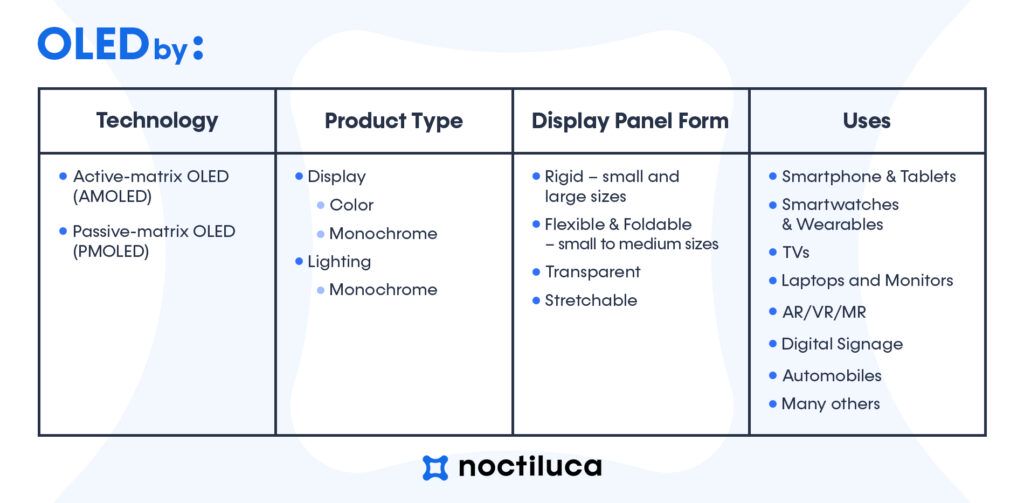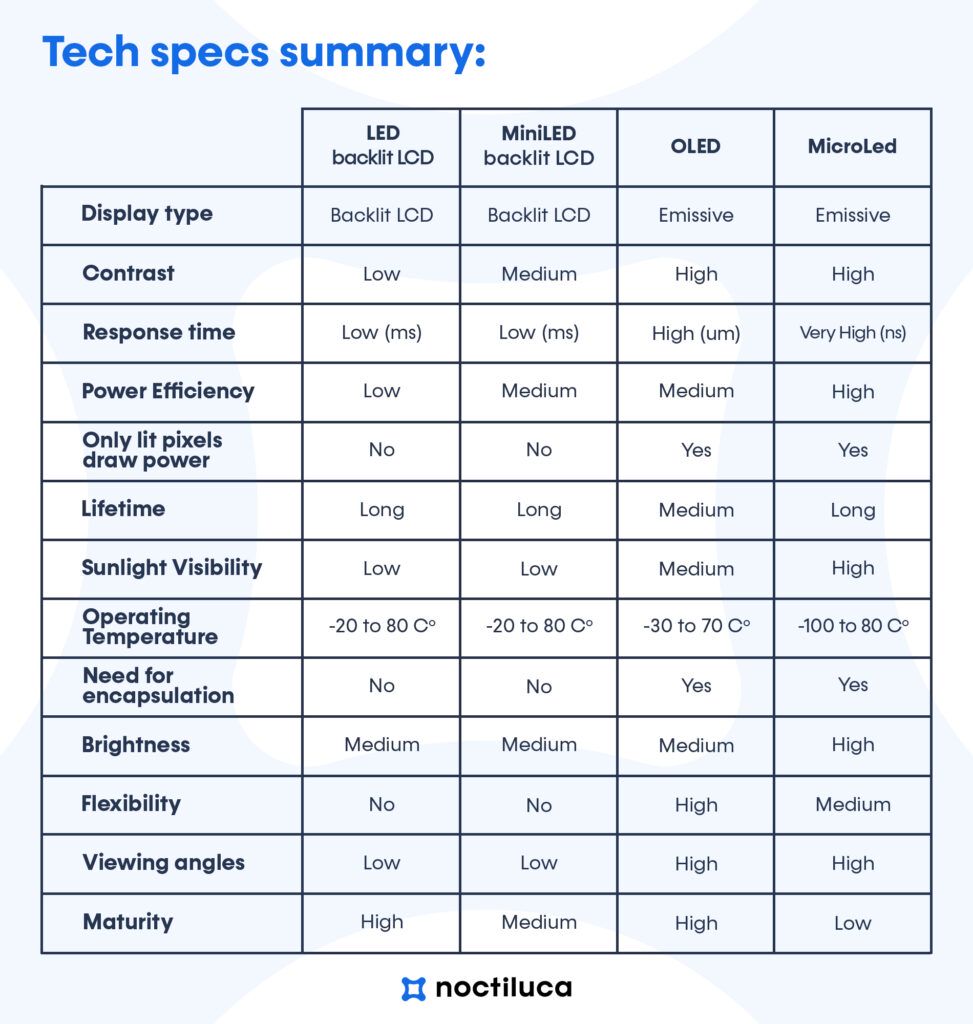March 2023
Blog post by Noctiluca
There are many types of displays in the market today. Noctiluca specializes in high-performance materials dedicated to OLED displays, but this is just a part of the solutions. What are the advantages of each technology? How are some better than others? And finally, which solutions are suited for the future? These questions are answered in the following overview.
1. LCD:
LCDs, or liquid crystal displays, are the oldest of all flat panel display types, they replaced CRTs as display of choice. LCD’s are constructed with two sheets of glass coated with ITO and liquid crystal material in between, bookended by polarizers; they are light valves and need a backlight and color filter to complete the assembly. Often they use BEF/DBEF films, diffusers etc. to enhance the quality of the display. Majority of the LCD in use are transmissive but there are also applications for reflective and transflective LCDs mostly in monochrome applications. Particularly, liquid crystals are tiny rod-shaped molecules that change their orientation in the presence of an electric field.
The concept of the active-matrix thin-film transistor (TFT) liquid-crystal display panel was prototyped in the United States in 1972.
In a display, this property can be manipulated to allow or block, light from passing through. Color filters are used to generate different colors; each pixel is made up of three sub-pixels, Red, Green and Blue, a combination of these (level of gray) can produce millions of colors. Since liquid crystals don’t produce any light by themselves, LCDs rely on a white (or sometimes blue) backlight. The liquid crystal layer then simply has to stop or let this light pass through, to create white or black pixels; a combination of different pixels create images. While well understood and mass produced, LCDs with backlight units are relatively thicker, heavier and aren’t flexible, meaning they are built on glass rather than on plastic substrates.
LCDs are used in a wide range of applications, including: LCD televisions, computer monitors, instrument panels, aircraft cockpit displays, indoor and outdoor signage. Small LCD screens are common in LCD projectors and portable consumer devices such as digital cameras, watches, smartphones.
Technologies that enhance LCDs
LCD with Q-LED Backlight
The “Q” in QLED stands for “quantum dot,” a tiny semiconductor nanocrystal smaller than 10 nanometers. How small is that? There are a million nanometers in a millimeter, and a human hair measures around 80,000-100,000 nanometers. Each of these microscopic quantum dots is capable of emitting either red, green, or blue, from which billions of colours can be created. QLED TVs – sometimes expressed as “QD-LED” – include a panel of quantum dots that sits between the LCD panel and the LED backlight. Quantum dots heighten an LCD TV display’s overall colour accuracy and colour brightness, create deeper blacks, and enhance HDR (High Dynamic Range) contrast. In this type of display, the LCD matrix plays the role of shutters to prevent the light from bleeding onto the switched off (Black) pixels . Plus, it filters the light to reconstruct the color on display. It is a modern and complicated method that companies like Samsung have made for providing a high-quality display to the users. This technology can produce high brightness in some devices displays but doesn’t reproduce the dark and light tones like an OLED. QLED backlit LCD leverages existing, fully amortized LCD fabs therefore lower cost, they can scale to large diagonal size displays, they generate sufficient color that allows LCDs to get closer to OLED performance.
LCD with Mini-LED Backlight
The Mini-LED is a new type of backlight used for with LCD TV. They are a form of miniature LEDs that are configured in a full matrix to achieve Full Array Local Dimming (FALD) zones. By using miniLED FALD backlights, the miniLEDs directly behind the black pixels can be switched Off while keeping the miniLEDs behind the white pixels switched On. This leads to better contrast and HDR that brings performance closer to OLED. Mini-LED uses techniques that allow control at the zone level rather than the entire display. By using a lot of zones, very small areas of the displays can be individually controlled and small groups of pixels can be impacted. This allows it to achieve the level of deeper blacks similar to that of OLED displays. This is still a backlight behind a LCD so the issues of depth, weight, and flexibility or lack thereof, remain.
2. OLED:
The current top-of-the-line display technology is OLED, which stands for organic light-emitting diode. The OLED is built from an electroluminescent layer that consists of organic compounds which emit light when a field is applied. Due to their light emitting characteristics, OLED-based panels do not need backlighting.
First practical OLED device – 1987 ( developed by Kodak, in December 2009 Kodak sold its OLED business to LG)
OLED have a much better contrast ratio due to their ability to display blackest blacks and whitest whites. The images are often stunning compared to other display technologies like LCD. From the outset, OLED has been a premium technology, offering superior picture quality, but at a substantially higher price than display options, such as LCD. Since OLEDs are organic, the life of these emitters are finite. While red and green OLED films have longer lifetimes (46,000 to 230,000 hours), blue organics currently have much shorter lifetimes (up to around 14,000 hours). Blue light emitter remains a challenge when it comes to longevity. That could lead to colour accuracy problems when the device gets older.
OLED displays are quite versatile. Below is a classification by different categories

OLED enhancement technologies
QD-OLEDs
According to Samsung Display, a QD-OLED display has three main components: a TFT layer that excites the OLED material, a layer of blue OLED material that generates light, and a layer of quantum dots for color conversion. When the blue light from each pixel is passed through the quantum dot layer, green and red sub-pixels are created, which, combined with the blue sub-pixel, make up the RGB color model. In this color model, red, blue, and green are added together to produce other colors for the pictures that you see on your TV.
3. Micro-LED
Micro-LEDs (μLEDs) have emerged recently as one of the next-generation displays. It is particularly attractive for transparent displays and high luminance displays and offers ultrahigh luminance and long lifetime (what is similar to Mini-LED technology). These features are highly desirable for sunlight readable displays, such as smartphones, public information displays, and vehicle displays. Like OLED, each icroLED in a icroLED display is a pixel, and each icroLED is self-illuminating and supplies its own colour. Unlike OLED, icroLED sets could be 30 times brighter with no burn-in or lifespan issues.
On the other hand, MicroLED displays are similar to OLED because they emit their own light, therefore requiring no backlighting. MicroLED is actually being touted as more superior in quality to OLED displays. They can provide more brightness along with higher contrast and richer colours, combining the best features of OLED and backlit LED. MicroLED are much smaller than Mini-LED. The size of the diodes is in the order of microns, so they are a millionth of a meter in size. Each MicroLED is placed in a pixel, thus they illuminate at the pixel level. Since they are tinier, they are also harder and costlier to produce, but more demand will bring economies of scale. MicroLED provide better luminance and higher resolution than OLED, so they are ideal for premium displays. MicroLED displays are exciting to many, as the technology seems to be the front runner for the next-generation display of choice in many market segments – from AR glasses through wearables to TVs and IT displays. The MicroLED industry though, even after billions of dollars spent on R&D, is still at a very early stage. Production costs are high, processes are not ready or reliable enough, and there are several technical challenges to overcome before production can begin. The main advantages of microLED displays will be the high-power efficiency and high brightness, and long lifetime of the LEDs and the ability to create very small pixels.
